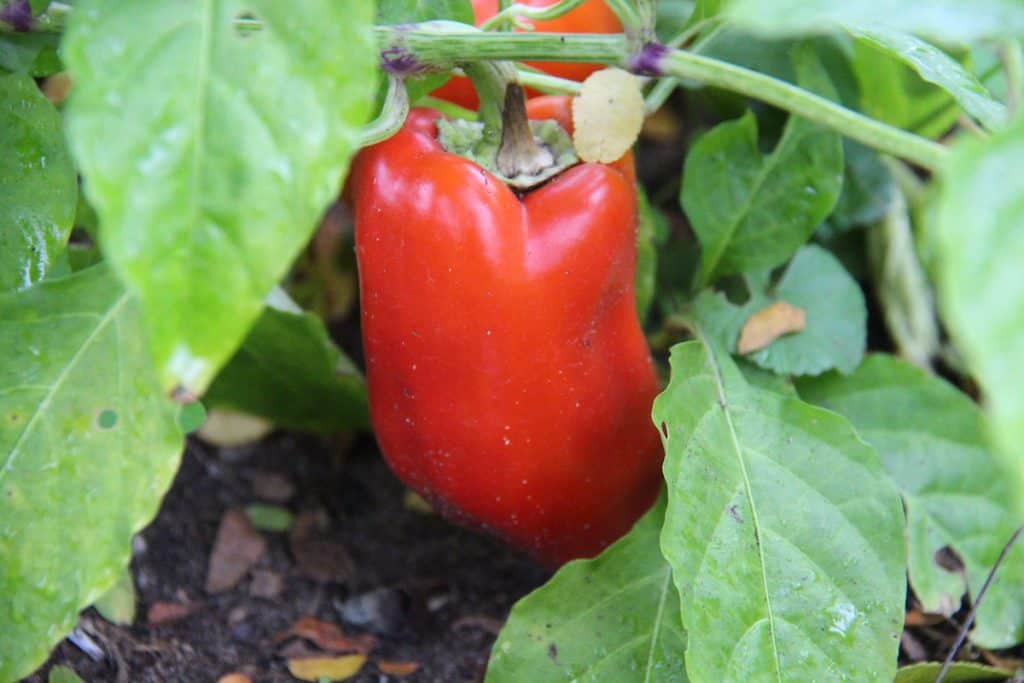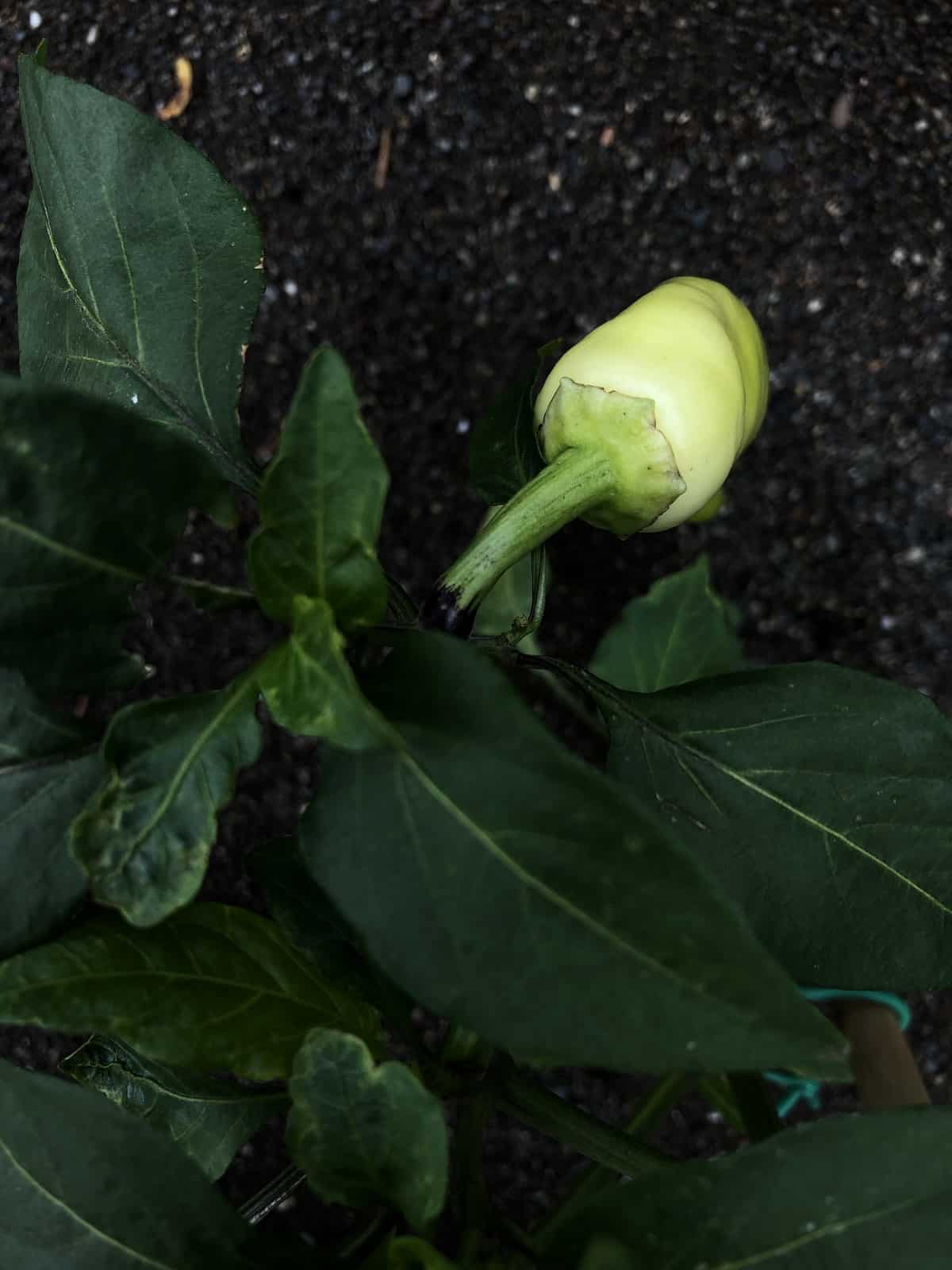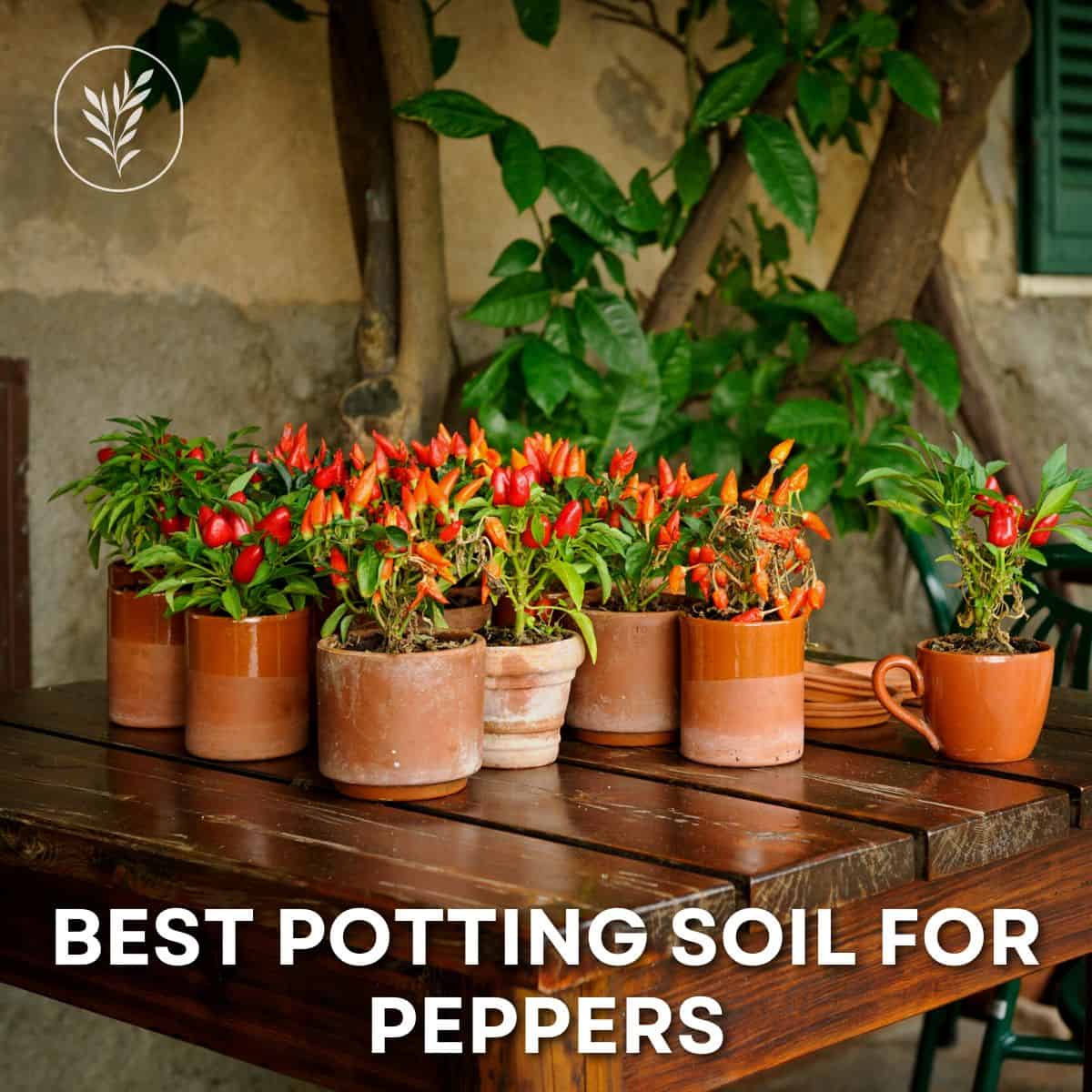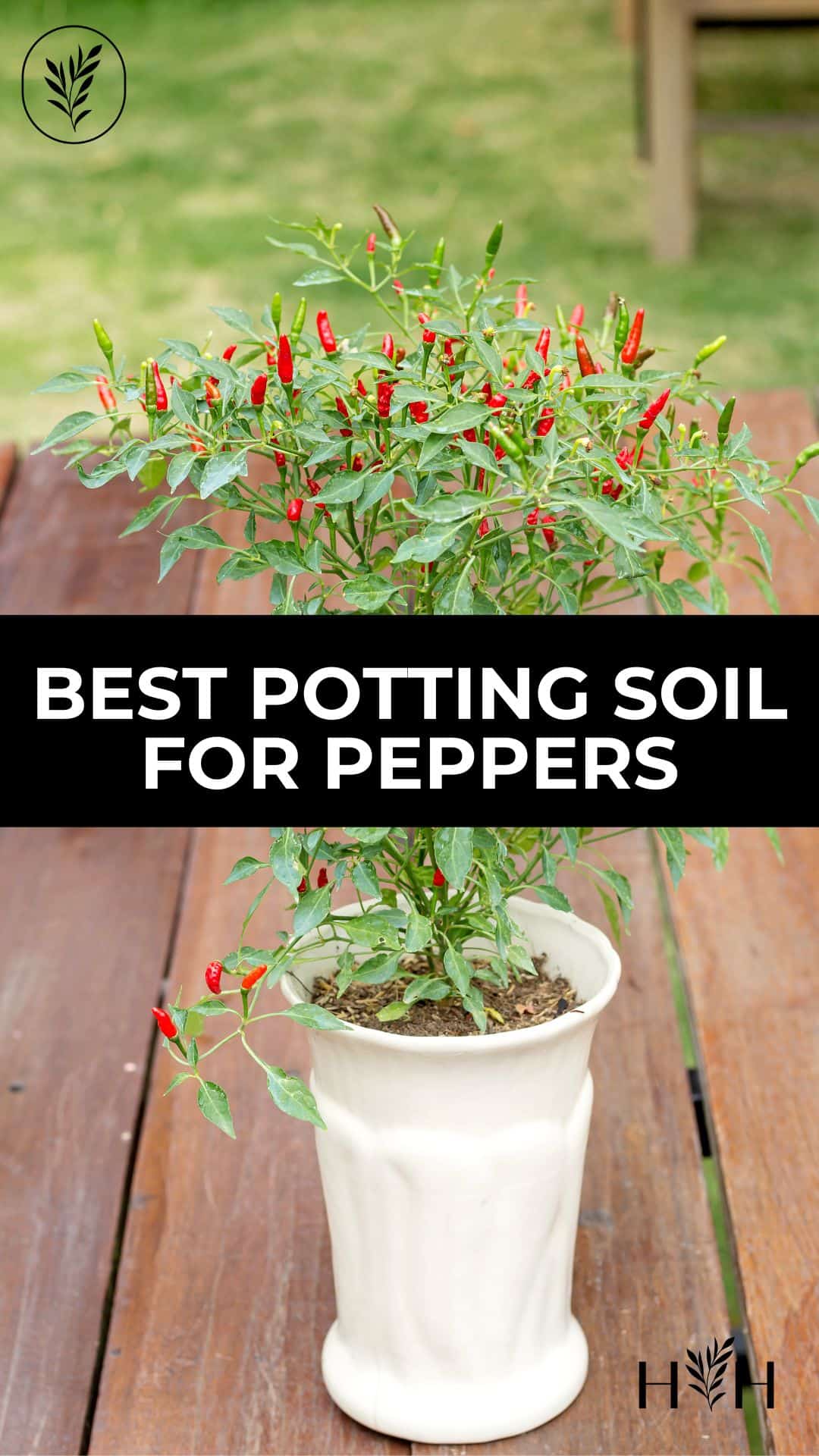Prepare to plant the pepper plot!!! Here is how to create the best potting soil for peppers so you can grow perfectly pungent peppers this year.
The best potting soil for peppers is:
- Well-drained; often contains perlite, sand, or vermiculite
- Rich in plant nutrients, enriched with organic compost
- pH-neutral, free of herbicides & contaminants
- Warm, exposed to full sun
Here are some great potting soil options for growing peppers:
- FoxFarm Ocean Forest Organic Potting Soil Mix
- Kellogg Garden Organics All Natural Premium Outdoor Potting Mix
- Miracle-Gro Performance Organics All-Purpose Potting Soil Mix
- Nature’s Care Organic Potting Mix
Peppers grow best outdoors in well-drained, ph-neutral, organic, sandy loam soil or quality potting mix, often with the addition of some quality homemade compost. Read on to learn more about creating the best potting soil for your pepper plants.
“When care is taken to improve the soil and provide the best drainage possible, great pepper plants are usually the result.”
The Complete Chile Pepper Book: A Gardener’s Guide to Choosing, Growing, Preserving, and Cooking, by Dave DeWitt & Paul W. Bosland
Creating the best potting soil for peppers
Gardeners can create ideal soil conditions for peppers by optimizing their soil matrix for plant health. While peppers can survive in soil that isn’t ideal in all ways, pepper plants can thrive when their soil is properly prepared. In the passage below, pepper experts Dave DeWitt & Paul W. Bosland explain soil treatment for perfect pepper plots:
“It is unlikely that the perfect soil for growing peppers exists in the natural state anywhere, so some soil treatment will undoubtedly be necessary. Generally speaking, the best pepper-growing plot has several characteristics:
The Complete Chile Pepper Book: A Gardener’s Guide to Choosing, Growing, Preserving, and Cooking, by Dave DeWitt & Paul W. Bosland
-a warm, full-sun location
-well-drained loam or sandy loam high in organic material but with moderate fertility
-a herbicide-free environment
-little or no alkali
-a pH registering from 6.0 to 8.0 (ideally 6.7 to 7.3)”
If purchasing bagged potting soil, ensure that the potting soil matches these characteristics. Look for a well-draining balanced organic potting mix that contains perlite for drainage.
If growing peppers outdoors in garden soil, be sure to get your garden soil tested so you know what you’re dealing with. Getting a soil test is the only way to properly plan out a soil treatment strategy. Indiscriminate soil treatment is NOT RECOMMENDED:
So, to grow great peppers, garden soil should contain organic matter (not just mineral soil), drain water easily, and get lots of sunlight and warmth. These soils tend to be sandy loams in sunny areas with a bit of elevation for drainage (and a heaping helping of homemade compost).
“Peppers grow best in fertile, well drained soil where they will receive a maximum amount of sunlight. Sandy loam soils high in organic matter are best for an early crop because the soil warms up fast and drains quickly.”
Peppers: Growing Tips, University of Massachusetts Amherst
“Peppers grow best in fertile, well-drained soils with high levels of organic matter and full sun exposure (i.e., at least six hours of direct sunlight each day). Since peppers thrive in a soil pH ranging from 6.0 to 7.5, it would be prudent to have your soil tested at the planting site prior to planting.”
Growing Peppers in Home Gardens, Washington State University Extension

Creating well-draining soil
Well-draining soil means the soil allows water to flow through it, preventing waterlogging. Pepper plants need both water and air in their soil. Without enough air, roots can become waterlogged, leading to poor health or disease.
Adding materials like sand, perlite, or pumice to the soil helps with drainage. This allows the soil to hold the right amount of water and air. Good drainage is crucial, especially during the harvest season. Without it, pepper plants are at risk of diseases, often fungal infections due to too much water.
Pepper plants thrive in well-draining soil that allows water and air balance, preventing root waterlogging and diseases. Improving soil drainage with materials like sand, perlite, or pumice is vital, especially during harvest season, to reduce disease risk. In wetter areas, gardeners often use raised beds or construct a scree layer beneath the garden for enhanced water drainage and soil quality control.
A scree is a layer of crushed rock or gravel and sand under the garden for better water drainage. Instead of going to the bother of building a scree, many gardeners prefer using raised beds for growing peppers. This ensures better control over soil quality and drainage.
Enriching pepper potting soil with organic matter
Soil organic matter (SOM) is key to the health of your pepper plants. The organic matter is a huge contributor to soil’s ability to hold the right amount of water and the right amount of air. It really does contribute to improving the moisture content of the soil. Almost all pepper gardeners rely on compost to grow great peppers. You can either make your own compost (highly recommended!) or purchase pre-made compost.
Mulching soil around pepper plants
Mulch should be applied once the soil is warmed. Just as you should wait until the soil has warmed to plant the pepper outdoors, you should also wait to mulch it. Let the soil come up to temperature with the heat of the spring before applying a healthy mulch of compost on top of the soil.
Some gardeners like to mulch their pepper plants with coffee grounds. But are coffee grounds good for pepper plants? Yes, coffee grounds are good for pepper plants – but they’re best in limited doses and they really should be composted first. Pure raw coffee grounds compact easily and can create a crusty barrier that restricts soil airflow. Sprinkling some around the plant can look nice as an aesthetic soil mulch, but the thickness of the grounds shouldn’t be more than about 1 cm (less than half an inch). Just compost them.
“Mulching with herbicide-free grass clippings, weed-free straw or other organic material to a depth of three to four inches can help prevent weed growth, decreasing the need for frequent cultivation.”
Growing peppers in home gardens, University of Minnesota Extension
Soil nutrients for growing healthy pepper plants
Pepper plants, like other garden vegetables, are often given various plant foods. That being said, many garden soils already contain enough available nutrients to support healthy pepper plants. Don’t risk upsetting the natural nutrient ratios without doing a soil test. Use organic fertilizer to address any nutrient deficiencies noted by the soil testing laboratory.
Pepper growers often front-load with a high-nitrogen fertilizer, applying most of it when the plant is getting established and focused on growing foliage. Once the plant sets its first fruit, it’s time to hold back on the nitrogen and focus on adding nutrients required for fruiting if any nutrient deficiencies were noted in the soil test. Too much nitrogen can make a pepper plant that’s all leaves and no peppers.
Pepper plants that have received the right amount of nitrogen grow lots of foliage and are more likely to grow more peppers. Don’t add extra “for good luck” (that’s not how soil health works). An overload of nitrogen can lead to a plant that’s all leaves and no peppers, or worse, peppers with blossom end rot (BER):
“Research has shown that Ca in soil solution competes with potassium (K), magnesium (Mg) and ammonium-nitrogen (NH4-N) for uptake in the plant. Although no established guidelines exist to determine what proportions of these nutrients in soil or plant tissue are appropriate, it is known that excessive shoot growth resulting from overfertilization of N and K during early bloom and fruiting stages is a major contributor to BER in developing fruit.
Since Ca moves with the transpirational water flow, water is going to go to areas of new shoot growth that have the greatest transpirational demand. Calcium will therefore be deposited in the new shoot and leaf tissues that result from excess fertilization, and little will end up in developing fruit where it is needed most. At early bloom stage for bell pepper and tomato, leaf N and K analysis should both be within 4.0 to 6.0 percent. Levels higher than these may indicate excess fertilizer.”
Blossom-End Rot and Calcium Nutrition of Pepper and Tomato, University of Georgia Extension
Fertilized plants will likely need staking to support the extra fruit set that extra foliage enables. Plan on staking and tying the pepper plants during planting so that it’s easier to support them when they need it.
“Use a starter fertilizer when transplanting. Apply supplemental fertilizer (side-dressing) after the first flush of peppers is set.”
Watch Your Garden Grow: Peppers, University of Illinois Extension
More soil considerations for peppers
Avoid soil contaminated with disease, pests, and heavy metals. None of these contaminants are good for your peppers and certainly may be harmful. Don’t buy pepper plants that are clearly infected with the soil-borne disease. Follow good cultural disease control practices like crop rotation.
Soil temperature is also key. Peppers do not react well to cold soil. Wait until the outdoor soil has warmed in the spring before planting the pepper outside. Don’t rush the season! Here are some specifics:
“Transplant outdoors after nighttime low temperatures are above 50°F.”
Growing peppers in home gardens, University of Minnesota Extension
“When night temperatures are below 50° to 55°F, the plants grow slowly, the leaves may turn yellow and the flowers drop off. Raised beds, black plastic mulch and floating row covers may be used to advantage with peppers to warm and drain the soil and enhance the microenvironment of the young pepper plants in spring, when cool weather may persist.”
Watch Your Garden Grow: Peppers, University of Illinois Extension










